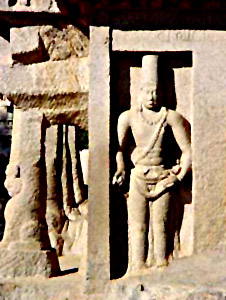Introduction
 Pallava sculptures came into being from the 4th to 9th centuries. It was during the Pallava reign that the rock cut architecture flourished. The earliest specimens of Pallava art and architecture dated back to the 610 to 690 AD. The other temples, on the other hand, were constructed from 690 to 900 AD. In fact, the rock cut caves also came into trend during the Pallava Empire. For the first time the, a predominant feature of the South Indian temples, were fast replaced by the innovative rock architecture and sculptures.
Pallava sculptures came into being from the 4th to 9th centuries. It was during the Pallava reign that the rock cut architecture flourished. The earliest specimens of Pallava art and architecture dated back to the 610 to 690 AD. The other temples, on the other hand, were constructed from 690 to 900 AD. In fact, the rock cut caves also came into trend during the Pallava Empire. For the first time the, a predominant feature of the South Indian temples, were fast replaced by the innovative rock architecture and sculptures.
History of Pallava sculptures
Sangam Period"s traditional Manimekalai, features the beginning of the first Pallava King from a connection between the daughter of Naga king of Manipallava, named Pilli Valai with a Chola king Killivalavan. One more description states that "Pallava" was born from the union of the Brahmin Ashvatthama with a Naga Princess also supposedly supported in the sixth verse of the Bahur plates. The Pallavas themselves claimed to move down from Brahma and Ashvatthama. Although to the Manimekalai posits, Ilam Tiriyan as a Chola, not a Pallava, the Velurpalaiyam plates dated to 852, do not bring up the Cholas.
Various Pallava Sculptures
The Pallavas initiated the skill of excavating temples from the rock. In fact, the Dravidian style of temple architecture began with the Pallava rule. It was a regular development starting from the cave temples to monumental rathas and concluded in structural temples. The growth of temple architecture under the Pallavas can be seen in 4 stages. Mahendravarman I introduced the rock-cut temples. This style of Pallava temples are seen at places like Mandagappattu, Mahendravadi, Mamandur, Dalavanur, Tiruchirappalli, Vallam, Siyamangalam and Tirukalukkunram pallava art. The second stage of Pallava architecture is represented by the monolithic rathas and Mandapas found at Mamallapuram. Narasimhavarman I took the recognition for these magnificent architectural monuments. The five rathas, generally called as the Panchapanadava rathas signifies five diverse styles of temple architecture. The mandapas enclose stunning sculptures on its walls.
The last stage of the Pallava art is also represented by structural temples built by the later Pallavas. The Vaikundaperumal temple, Muktheeswara temple and Matagenswara temples at Kanchipuram belong to this stage of structural design. The Pallavas were involved in the evolution from rock-cut architecture to stone temples. The earliest examples of Pallava constructions are rock-cut temples dating from 610 to 690 and structural temples between 690 to 900. A number of rock-cut cave temples bear the message of the Pallava king, Mahendravarman I and his descendants. The Kailasanatha temple in Kanchipuram and the Shore Temple built by Narasimhavarman II, rock cut temple in Mahendravadi by Mahendravarman are fine examples of the Pallava style temples.
Features of Pallava Sculptures
The features of Pallava sculptures are identical to the Dravidian art and sculpture. It was during the reign of the Pallavas that the rock cut architecture was replaced by stone structures. The detailed sculptures and the colossal temples stand tall even today and bear testimony to the artistic wizardry of the age. The temples at Kanchipuram and Mahabalipuram are some of the finest examples of Pallava architecture. As far as sculpture and architecture are concerned they were mainly concentrated to religion. The sculptures were mainly carved out of granite that is considered one of the hardest rocks.
 Inspite of being influenced by the Dravidian style the Pallava architecture and sculpture evolved its own set of features as well. the temples that were built have big forms, the anatomy of the sculpted figures were plain and simple, less ornamentation, elongated faces with large eyes, thick lips, double chin, broad nose and others were common features for the sculptures.
Inspite of being influenced by the Dravidian style the Pallava architecture and sculpture evolved its own set of features as well. the temples that were built have big forms, the anatomy of the sculpted figures were plain and simple, less ornamentation, elongated faces with large eyes, thick lips, double chin, broad nose and others were common features for the sculptures.
As far as the Pallava temple sculptures are concerned the figures of mythological gods and goddesses, elephants and warriors are found on the temple walls. The black coloured Goddess Kali as the destroyer is also seen. Besides these the image of Lord Shiva is also a popular motif. The sculpture of Kailashanath temple at Kanchipuram is a fine example to get acquainted with the features of Pallava sculptures and architecture. Apart from this there is the Shore Temple at Mahabalipuram has also been built on the Pallava idiom. Pallava art also travelled to South East Asia. The features of this style are evident from the Temple of Angkor Vat in Cambodia.



















